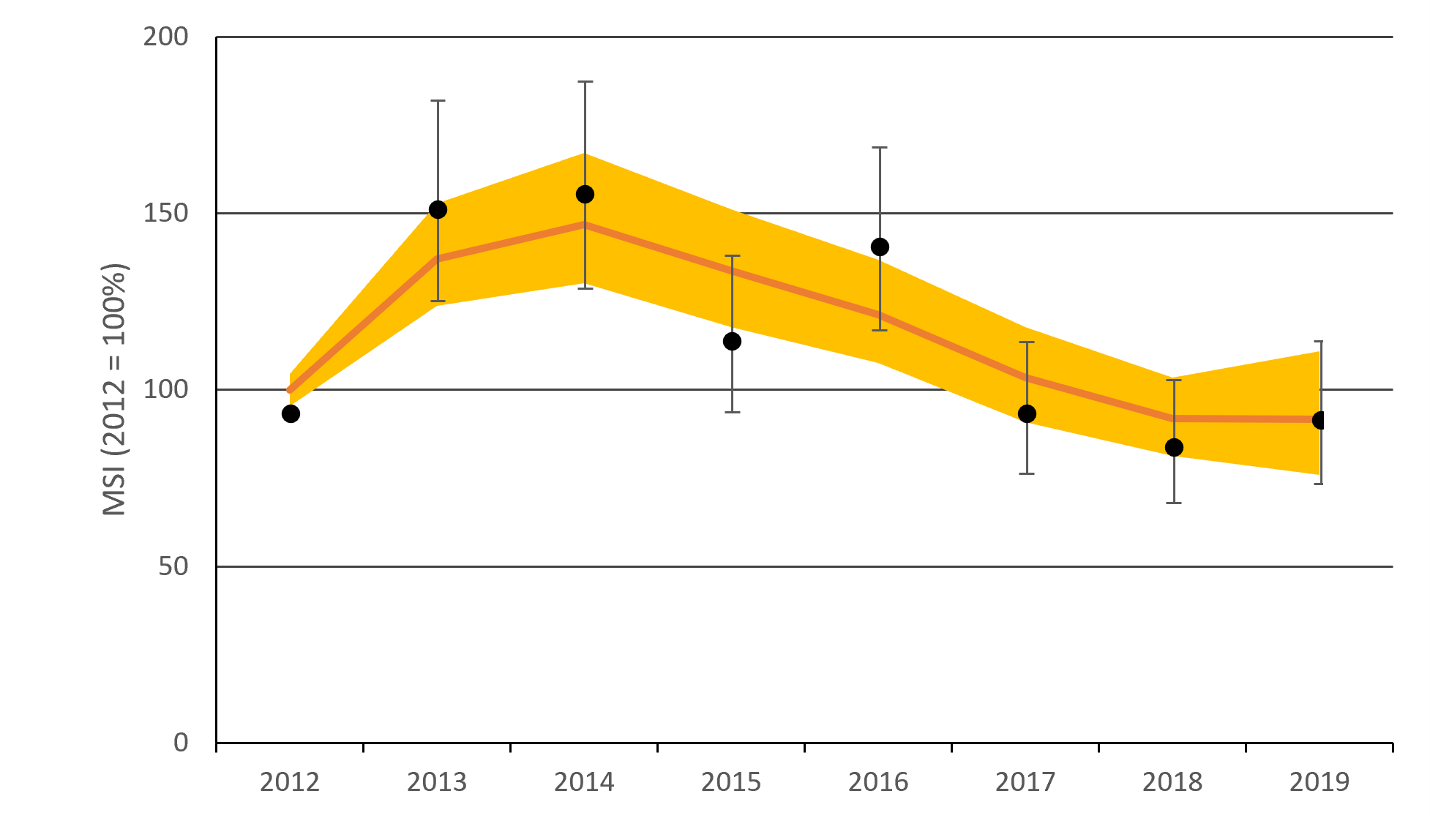| Current status | 2022 |  |
| Short term status | 2018 - 2022 |  |
| Long term status | 2012 - 2022 |  |
Click on the charts below in order to see the full resolution versions.
Bumblebee populations are sensitive to changes in climate, land-use and agricultural practices at moderate to large spatial and temporal scales. Of the 98 bee species in Ireland, 20 are bumblebees. However, in terms of the numbers of individual bees, bumblebees typically comprise more than 80% of Irish wild bee communities, hence their prominence as our most important group of pollinating insects (Murray et al., 2012). At present, seven species bumblebee are under threat of extinction in Ireland (Fitzpatrick et al., 2006).
This indicator is derived from systematic monitoring schemes coordinated by the All-Ireland Bumblebee Monitoring Scheme and the National Biodiversity Data Centre in collaboration with the Bumblebee Conservation Trust in Northern Ireland, and is the first national-level bumblebee recording scheme in the world. Trailed in 2011 and running since 2012, the monitoring scheme currently has ca. 105 sites walked by 80 citizen-scientists distributed across the island Ireland recording bumblebee species and abundance using a fixed-width transect count method along a 1-2 km route, each month between March and October. It is also a key component of the All-Ireland Pollinator Plan 2015-2020 in terms of tracking implementation of the Plan and its impact on our wild pollinator populations.
The population data from each species is analysed using TRIM (Trends and Indices for Monitoring data; Pannekoek & van Strien, 2005), a programme to analyse time-series of counts with missing observations using Poisson regression. Each year, the geometric mean of the indices for each species is calculated and a 95% confidence interval estimated by Monte Carlo simulation (Soldaat et al., 2017).
Based on eight common and widespread species, the multi-species index shows that there is an overall loss across bumblebee populations since 2012. The current overall trend from 2012-2022 is a year-on-year decline of 3.3% (with a 95% confidence interval). According to the Annual Newsletter 2021-2022, while there are eleven years of data, it is still necessary to err on the side of caution in reading too much into these trends. A longer term dataset is necessary to smooth out the fluctuating impacts of Irish weather.
On a per species basis, from 2012-2022, two are in decline (Bombus pascuorum [Common Carder Bee] and Bombus muscorum [Large Carder Bee]), one is stable(Bombus terretris [Buff-tailed Bumblebee]) and five are too variable to assign statistically rigorous trend. A further 12 species lack sufficient data for their population sizes to be formally assessed.
More information on the All-Ireland Bumblebee Monitoring Scheme can be found here:
http://www.biodiversityireland.ie/record-biodiversity/bumblebee-monitoring-scheme/
More information on the All-Ireland Pollinator Plan 2015-2020 can be found here:
The International Union for the Conservation of Nature (IUCN) Regional Red List for Irish bees is available here: http://www.npws.ie/publications/redlists/
The International Union for the Conservation of Nature (IUCN) European Red List for Bees is available here: https://www.iucn.org/content/european-red-list-bees
More information on the Bumblebee Conservation Trust, U.K. can be found here:
http://bumblebeeconservation.org/
References:
Fitzpatrick, Ú., Murray, T.E., Byrne, A., Paxton, R.J. & Brown, M.J.F. (2006) Regional Red List of Irish Bees. National Parks and Wildlife Service (Ireland) and Environment and Heritage Service (N. Ireland). http://www.npws.ie/publications/redlists/Fitzpatrick_et_al_2006_Bee_Red_List.pdf
Murray, T.E., Fitzpatrick, Ú., Byrne, A., Fealy, R., Brown, M.J.F., Paxton, R.J. 2012. Local-scale factors structure wild bee communities in protected areas. Journal of Applied Ecology 49: 998-1008.
Pannekoek, J., van Strien, A. 2005. TRIM 3 manual. TRends and Indices for Monitoring data. Research Project No. 100384. Voorburg, The Netherlands: Statistics Netherlands. http://www.cbs.nl/en-GB/menu/themas/natuur-milieu/methoden/trim/default.htm
Soldaat., L.L., Pannekoek, J., Verweij, R.J.T., van Turnhout, C.A.M., van Strien, A.J. 2017. A Monte Carlo method to account for sampling error in multi-species indicators. Ecological Indicators 81: 340-347.


